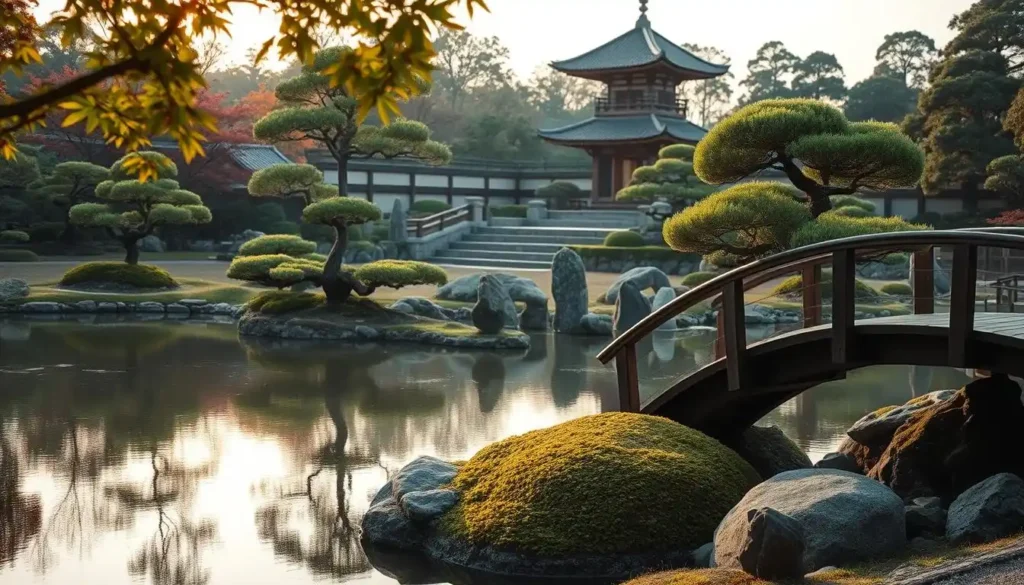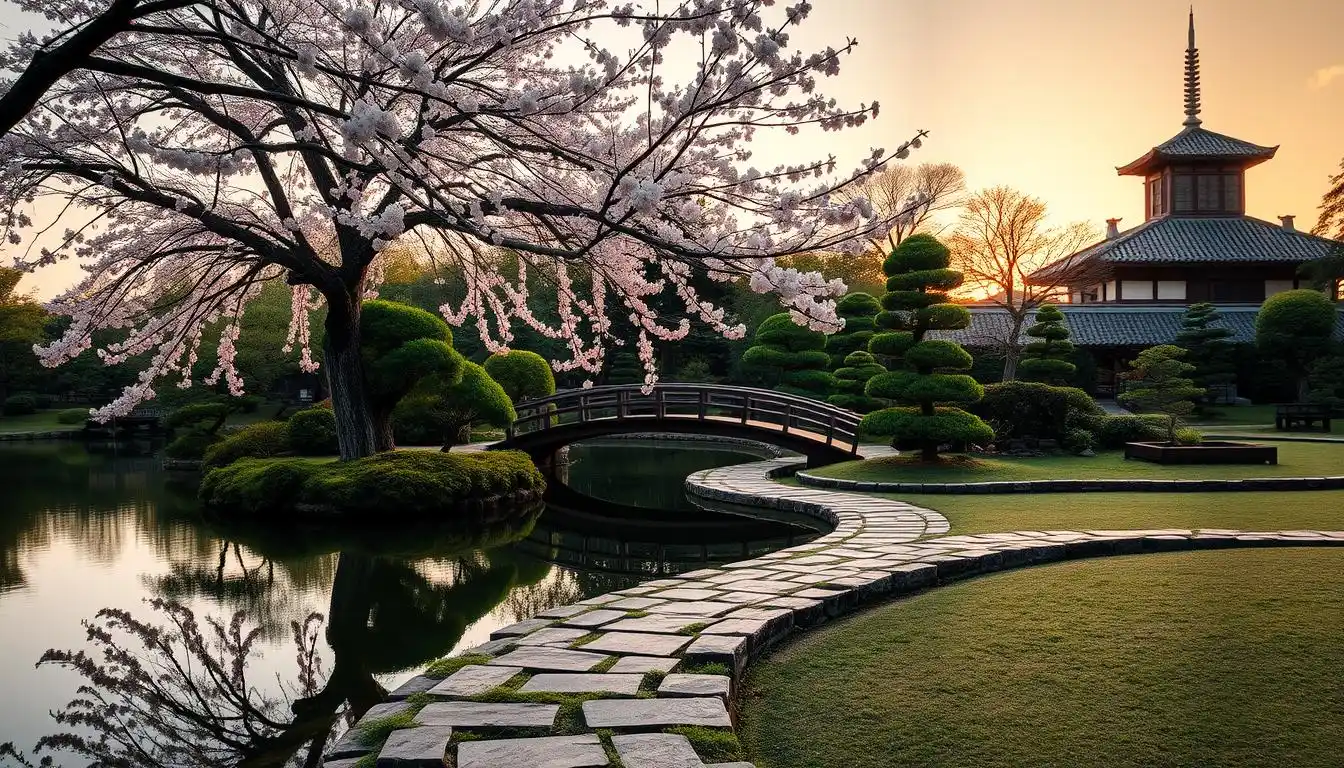Exploring Japanese garden design opens a door to a serene world. It turns your outdoor space into a peaceful oasis. These gardens connect you with nature, bringing calm and serenity.
By using key elements and design principles of Japanese gardens, you can make a peaceful retreat. It can be in a small yard or a large landscape. Japanese garden inspiration helps you create a unique and captivating outdoor space.
Key Takeaways
- Discover the essence of Japanese garden design
- Learn about key elements and design principles
- Find inspiration to create your own tranquil oasis
- Understand how to incorporate Japanese design into your space
- Create a peaceful retreat that reflects your personal style
The Philosophy Behind Japanese Gardens
Learning about Japanese garden philosophy can change how you see these peaceful places. These gardens are more than just pretty views. They reflect deep ideas that guide their design.

Wabi-Sabi: Finding Beauty in Imperfection
Wabi-Sabi is a key part of Japanese gardens. It celebrates the beauty of things that are imperfect and fleeting. This idea helps us see the beauty in the simple, unpretentious parts of life.
In a garden, Wabi-Sabi means using natural, weathered materials. It also means accepting the changes that come with the seasons. By embracing imperfection, your garden can feel real and calm.
Ma: The Concept of Negative Space
Ma is about the empty space or void in a garden. It’s as vital as the physical parts of the garden. This idea brings balance and harmony, encouraging us to think deeply and be mindful.
By adding Ma to your garden, you can make a space that’s both beautiful and peaceful. The empty space helps guide the eye and brings calm.
Understanding and using these ideas can make your Japanese garden more than just a pretty view. It can be a place that nourishes your spirit.
Essential Elements of Traditional Japanese Gardens
To design a traditional Japanese garden, you need to think about key elements. These include water features, stone arrangements, and pathways. Together, they make a peaceful and thoughtful space.
Water Features: Ponds, Streams, and Waterfalls
Water features are vital in traditional Japanese gardens. They symbolize life’s flow. Ponds, streams, and waterfalls bring calm and tranquility. The sound of water adds to the garden’s serene feel, perfect for relaxation.

Stones and Rock Arrangements
Stones and rock arrangements are chosen and placed to look like mountains or islands. They add depth and texture. The art of arranging stones is complex, needing a deep understanding of nature.
“The rock garden is a sacred space, a place where the boundaries between nature and art dissolve.”
Bridges and Pathways
Bridges and pathways help visitors move slowly and thinkfully through the garden. They enhance the garden’s beauty and offer a way to explore. The materials and design of bridges and pathways greatly affect the garden’s mood.
| Element | Purpose | Design Consideration |
|---|---|---|
| Water Features | Symbolize the flow of life | Sound, movement, and reflection |
| Stones and Rock Arrangements | Represent mountains or islands | Size, shape, and placement |
| Bridges and Pathways | Guide visitors through the garden | Material, design, and flow |
By using these key elements, you can make a traditional Japanese garden. It will be a peaceful and real place, offering a calm escape in your yard.
Japanese Garden Design Ideas for Small Spaces
Turning small areas into Japanese gardens is simpler than you might think. A bit of creativity can transform even the tiniest spots into calm retreats. These spaces can mirror the beauty of Japanese garden design.

Courtyard Japanese gardens are great for making the most of your home’s space. Adding stone lanterns, water features, and the right plants can create a peaceful spot. It’s perfect for unwinding.
Courtyard Japanese Gardens
Courtyard gardens use the space around your home well. Use natural materials like wood and stone. Adding water features, like a small pond or fountain, brings calming sounds.
Container Gardens with Japanese Elements
For those with little space, container gardens with Japanese touches are a good choice. Use pots and planters to create a mini Japanese garden on balconies, patios, or indoors. Choose plants like bonsai trees or Japanese maples that fit well in containers.
Balcony Zen Gardens
Balcony Zen gardens offer a quiet escape in the city. Start with a few plants, like moss or bamboo, and add natural elements like rocks and gravel. Keep it simple and uncluttered to foster calm.
As
“The garden is a love song, a duet between a human being and Mother Nature.”
– Allen Lacy. This quote captures the essence of creating a Japanese garden in small spaces. It’s about finding harmony with nature.
By using these Japanese garden design ideas for small spaces, you can make a peaceful oasis. It brings tranquility to your everyday life.
Creating a Zen Garden: Simplicity and Meditation
Creating a Zen garden means embracing simplicity. It’s a space for calm and inner peace. The key is to use elements that promote mindfulness and meditation.
Choosing the right elements is crucial in Zen garden design. A few well-chosen pieces can create a calm and reflective space.
Selecting and Arranging Rocks
Rocks and stones are key in a Zen garden. They can symbolize mountains or islands. When selecting rocks, think about their shape, size, and texture. Also, how they fit with other garden elements is important.
The way rocks are arranged should bring balance and harmony. It invites you to think deeply.
Sand and Gravel Patterns
Sand and gravel add to the garden’s calm feel. Raking them into patterns is both interesting and meditative. It’s like the patterns themselves are a form of meditation.
Incorporating Minimal Plant Life
While plants aren’t the main focus, they can add to the garden’s peace. Choose simple, unobtrusive plants that fit the garden’s look. Moss can add softness, and pruned trees can offer shade and shape.
With these elements, you can make a Zen garden that’s a peaceful place for meditation and reflection.
Japanese-Inspired Water Features
Japanese-inspired water features like tsukubai and koi ponds can turn your garden into a peaceful oasis. These features are key in Japanese gardens, adding beauty and meaning. They help create a calm and serene atmosphere, encouraging you to enjoy nature’s beauty.
The tsukubai is a famous Japanese water feature, a basin for purification rituals. It symbolizes cleansing the mind and body, preparing you for the garden’s spiritual experience. Tsukubai are made from natural stone and are used in rituals, focusing on mindfulness.
Tsukubai: Water Basins and Their Significance
Tsukubai are not just for rituals; they’re also beautiful additions to the garden. They create a moment of stillness, helping you reflect and connect with nature. When adding a tsukubai, think about its placement to enhance its impact.
Shishi-Odoshi: Deer Scarers and Bamboo Fountains
The shishi-odoshi, or deer scarer, is actually a bamboo fountain that makes a soothing sound. It was once used to scare deer but is now loved for its sound. The bamboo’s movement and the water’s sound create a peaceful atmosphere.
Koi Ponds and Their Symbolism
Koi ponds symbolize good fortune and prosperity in Japanese gardens. Koi fish represent perseverance and strength. The ponds are designed to be visually stunning, with stones and plants. Adding a koi pond brings depth and meaning to your garden.
Adding Japanese-inspired water features to your garden adds depth and meaning. Whether it’s a tsukubai, shishi-odoshi, or koi pond, each feature enhances your garden’s serenity and beauty.
Japanese Garden Design Ideas for Plants and Trees
Choosing plants and trees for a Japanese garden is an art. It’s about understanding their meanings and how they change with the seasons. This careful selection helps create a garden that shows nature’s beauty and peace.
Japanese Maples and Ornamental Trees
Japanese maples (Acer palmatum) are key in Japanese gardens. They’re loved for their bright leaves and gentle shapes. There are many varieties, showing colors from deep reds to soft pinks and greens.
Ornamental trees like cherry blossoms (Prunus serrulata) bring beauty in spring. Their blossoms signal the start of spring.
- Choose varieties that thrive in your local climate.
- Consider the mature size of the tree to ensure it fits your garden space.
- Plant trees in a way that creates a balanced and harmonious landscape.
Bamboo and Grasses
Bamboo is vital, adding movement and flexibility. Its sound in the wind enriches the garden’s feel. Grasses help create soft lines, blending with the garden’s other parts.
Tips for incorporating bamboo and grasses:
- Select non-invasive bamboo species to prevent unwanted spread.
- Use grasses to soften hard edges and create a natural transition between different areas of the garden.
Moss Gardens and Ground Covers
Moss gardens add serenity and age to Japanese gardens. They love shaded, moist spots, making a soft carpet. Ground covers like creeping thyme or vinca minor also help keep the garden lush and weed-free.
To start a moss garden, make sure it’s shaded and moist. Add moss spores or patches to help it grow.
Structural Elements in Japanese Gardens
Structural elements are key in Japanese gardens. They add beauty and peace. These parts make the garden special.
Japanese gardens have many structural elements. Each one has its own meaning and purpose. Let’s look at some important ones.
Torii Gates and Entrance Ways
Torii gates mark the entrance to Japanese gardens. They show the shift from everyday life to something sacred. Made of wood or stone, they are often red, showing their spiritual value. Adding a torii gate to your garden can make it feel more ritualistic.
Stone Lanterns and Their Placement
Stone lanterns light up Japanese gardens, making them feel cozy. They were used to light paths, especially for tea ceremonies. It’s important where you put them. Near water or at the entrance is best. Choose a lantern that fits your garden’s look.
Tea Houses and Pavilions
Tea houses and pavilions are central to Japanese gardens. They’re for thinking, relaxing, and tea ceremonies. Made from natural materials, they blend into the garden. Place them in quiet spots for the best effect.
Adding these elements makes your Japanese garden more real and lovely. It becomes a peaceful place for rest and thought.
When adding structural elements, keep these tips in mind:
- Choose materials that match the garden’s natural look.
- Make sure the size of the structures fits the garden.
- Put elements in a way that makes the garden flow well.
By carefully adding these elements, you can make a Japanese garden that’s both stunning and spiritually deep.
Seasonal Considerations for Your Japanese Garden
Japanese gardens are famous for showing off each season’s beauty. This makes it key to think about the seasons when designing your garden. By adding special touches for each season, your garden will stay fresh and exciting all year.
Spring: Cherry Blossoms and Azaleas
Spring brings new life to Japanese gardens with cherry blossoms and azaleas. These flowers add a burst of color, reminding us of life’s short time. To make your garden even more beautiful in spring, plant spring bulbs and add traditional Japanese spring themes.
Summer: Shade Gardens and Cooling Elements
Summer brings heat, but Japanese gardens offer cool spots. They use shade gardens and cool features like water and shaded areas. These help beat the summer heat, turning your garden into a refreshing retreat.
Fall: Japanese Maples and Autumn Colors
Fall paints Japanese gardens with Japanese maples and other trees. The autumn colors are stunning, making the garden a beautiful sight. Choose plants for their fall colors and add natural elements like leaves to enhance the view.
Winter: Snow Viewing Gardens
In snowy areas, Japanese gardens become snow viewing gardens. They feature trees, lanterns, and other elements to create a peaceful winter scene. These gardens invite quiet reflection and calm during the cold months.
By adding seasonal touches, your Japanese garden will be a peaceful and beautiful place all year.
Conclusion: Bringing Japanese Tranquility to Your Outdoor Space
Creating a peaceful outdoor space is easy with Japanese garden design ideas. These gardens bring calm by balancing nature’s elements like water, stones, and plants. This balance is key to Japanese garden tranquility.
Even with a small balcony, you can make a beautiful outdoor space. It’s all about choosing the right elements for a peaceful oasis. Think about adding traditional Japanese touches like stone lanterns or bamboo fountains.
Following the tips in this article, you can make a Japanese-inspired garden. It will be a place of beauty and calm. When designing, remember to mix beauty with function for a serene space.
FAQ
What are the key elements of a traditional Japanese garden?
Traditional Japanese gardens have water features like ponds and streams. They also have stones, bridges, and pathways. Plus, they use carefully chosen plants and trees.
How can I create a Japanese garden in a small space?
For a small space, use courtyards or container gardens. You can also design a balcony Zen garden. These spaces can be peaceful and tranquil.
What is the significance of water features in Japanese gardens?
Water features symbolize life’s flow. They are key in Japanese gardens. They make the garden calm and soothing.
How do I choose the right plants and trees for a Japanese garden?
Choose plants and trees native to Japan or with a similar look. Japanese maples, bamboo, and moss are good choices. They help create a true Japanese garden.
What is the concept of Wabi-Sabi in Japanese garden design?
Wabi-Sabi values the beauty of imperfection and change. It encourages simple, unpretentious beauty in life.
How can I incorporate seasonal elements into my Japanese garden?
Add seasonal elements like cherry blossoms in spring and Japanese maples in fall. Use shade gardens in summer and snow viewing gardens in winter. This keeps your garden interesting all year.
What is the purpose of a Zen garden?
Zen gardens promote meditation and mindfulness. They are simple, with a limited color palette. They use rocks, sand, and gravel.
Can I use modern materials in a traditional Japanese garden?
Yes, you can use modern materials while still respecting traditional Japanese garden design. It’s about blending old and new in a way that feels right.
How do I maintain a Japanese garden?
Keep your Japanese garden clean by pruning, watering, and cleaning regularly. Pay attention to seasonal changes and the needs of your plants and elements.

